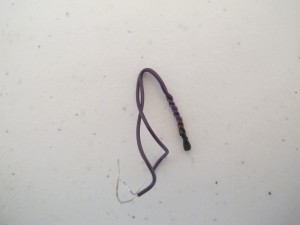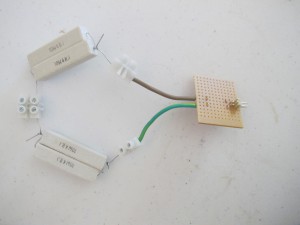We will start using this launch system for small Estee engines/igniters. So the first thing I wanted to do was model an Estes Igniter to find out how the battery would perform.
Below is a picture of a typical igniter.

The resistance was measured to be approximately 3.5 ohms.
If we assume resistance of battery and wires combined is approximately 0.5 ohms, we are looking at a total resistance of ~4 ohms. With an igniter battry of 12 volts, we are then looking at a current of approximately 3 Amps. This is well below the maxiumum current the relays can take (5Amps) and the wiress, connectors should be able to handle this current.
NOTE: When we get the relay board made to replace the current prototype, we will get 2Oz Copper board produced…which should double the current it can handle.
We really wanted to measure the resistance of the battery and the power dissapated by the battery. We do this because want to be sure the battery is not under too much ‘stress’. We know it _should_ be able to handle this current draw. It is rated as 10c (8Amp) continuous dis-charge and Max Burst ate of 20C (16Amp) so it should have absolutely no problems.

Nethertheless, we wish to understand its operation completely so that we are sure we don’t ignite the battery instead!
We decided to perform a small experiment to calculate the internal resistance when a current of 3Amps flows. Below is a picture of the test load.

Each resistor is a 10Watt resistor with a restance of 4 Ohms.
This means the total resistance of the load is 4 Ohms and it can dissapate a maximum of 40Watts (without exceeding specification of resistors).
We measure the open-circuit resistance of the battery and the closed-circuit resistance of the battery (when connected to the load). The values we got were:-
Vo = 12.15 V
Vc = 11.67 V
We then computed the internal resistance to be roughly 0.14ohms
So the power dissipated through the battery at a rate as shown below:-
P = VI = (12.15 – 11.67) ^2 / 0.14 = 1.6Watts
The power dissipated through the igniter is:-
P = VI = 11.67 ^2 / 3.5 = 38.9 Watts.
This is what we hoped for and expected. The igniter because of its much lesser mass should heat up significantly, exceedingly faster then the battery and ignite the pyrogen.
